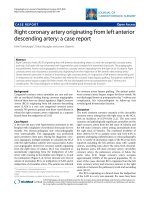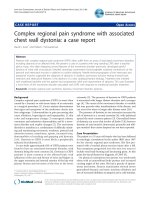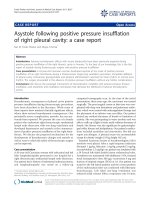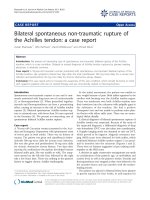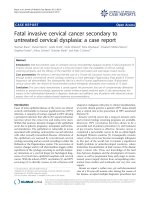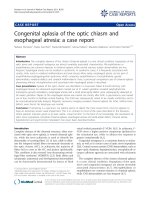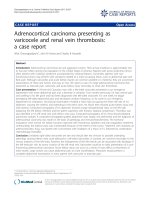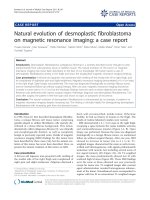Báo cáo y học: " Burned-out testis tumour that metastasized to retroperitoneal lymph nodes: a case report" ppt
Bạn đang xem bản rút gọn của tài liệu. Xem và tải ngay bản đầy đủ của tài liệu tại đây (1.14 MB, 4 trang )
Case report
Open Access
Burned-out testis tumour that metastasized to retroperitoneal
lymph nodes: a case report
Mehmet Yucel
1
*, Sahin Kabay
1
, Ugur Saracoglu
2
, Soner Yalcinkaya
2
,
Namik Kemal Hatipoglu
2
and Erol Aras
2
Address:
1
Department of Urology, Faculty of Medicine, Dumlupinar University, 43270 Kutahya, Turkey and
2
Department of Urology,
Okmeydani Educational Hospital, Istanbul, Turkey
Email: MY* - ; SK - ; US - ; SY - ;
NKH - ; EA -
* Corresponding author
Published: 29 May 2009 Received: 6 February 2008
Accepted: 22 January 2009
Journal of Medical Case Reports 2009, 3:7266 doi: 10.1186/1752-1947-3-7266
This article is available from: />© 2009 Yucel et al; licensee Cases Network Ltd.
This is an Open Access article distributed under the terms of the Creative Commons Attribution License (
/>which permits unrestricted use, distribution, and reproduction in any medium, provided the original work is properly cited.
Abstract
Introduction: Burned-out testicular tumour is a very rare clinical entity. There is no clinical finding
in the testicle, because it regresses spontaneously with no treatment, and generally presents with
metastases. Abdominal masses in young male patients may sometimes be caused by a metastatic
burned-out testicular tumour. We report a patient with a burned-out testicular tumour that
metastasized to retroperitoneal lymph nodes.
Case presentation: A 28-year-old man complained of an abdominal mass and continuously
increasing pain over the previous 2 months. A midabdominal mass, atrophy and minimal induration in
the right testis were revealed on physical examination. Ultrasound findings revealed focally increased
echogenicity, which is typical of burned-out tumours. Inguinal orchiectomy was performed, and the
histological examination of the biopsy specimen revealed a large area of hyalinization, tubular
hyalinization, interstitial fibrosis and focal Leydig cell hyperplasia, with no abnormal pathological
findings in the epididymis and spermatic cord. The final pathological diagnosis was concluded as
“burned-out” testicular tumour. Surgical treatment was followed by appropriate chemotherapy and
in the follow-up, the abdominal mass was observed to regress. The patient is currently free of disease
5 years after diagnosis.
Conclusion: For the detection of intratesticular lesions, especially in patients with extragonadal
metastatic involvement and normal palpation findings for the testis, scrotal sonography is very
important. A burned-out testicular tumour should be considered and testis biopsies should be
performed if there is any risk factor of malignancy.
Page 1 of 4
(page number not for citation purposes)
Introduction
Burned-out tumour of the testis is a very rare clinical
entity. The term ’burned-out’ tumour of the testis describes
a spontaneously and completely regressed testicular
tumour with no treatment. It presents by metastases to
the retroperitoneum, mediastinum, lymph nodes, lungs
and liver [1].
We report a patient with a burned-out testicular tumour
that metastasized to the retroperitoneal area. Testicular
germ cell tumo urs metastasize predominantly to the
retroperitoneal lymph nodes and subsequently to the
lungs.
Case presentation
A 28-year-old man complained of an abdominal mass and
continuously increasing pain over the previous 2 months.
Physical examination revealed a midabdominal mass on
abdominal palpation, atrophy and minimal induration in
the right testis on scrotal palpation. The left testis was
found to be normal. No abnormal finding was noted on
digital rectal e xamination. Examination of the other
systems, including the endocrine system, was normal.
His white blood cell count and urine microscopy were
normal. Aspartate amin otransferase (A ST): 56 mg/dl
(normally 1 to 40), alanine aminotransferase (ALT):
42 mg/dl (normally 1 to 38), alkaline phosphatase
(ALP): 768 mg/dl (normally 80 to 306), gamma glutamyl
transferase (GGT): 160 mg/dl (normally 6 to 50) and
lactate dehydrogenase (LDH): 6302 mg/dl (normally 266
to 501) were found in the blood biochemistry. His
erythrocyte sedimentation rate was high (110 mm/hour).
Values for alpha-fetoprotein (AFP) (5.9 ng/ml (normally 0
to 10.0)) and beta human chorionic gonadotrophin
hormone (b-hCG) (0.773 mIU/ml (normally <4)) were
within normal limits. Chest X-ray was normal. Scrotal
ultrasonogram revealed minimal hypoechogeneity and
non-homogeneity in the right testis. Abdominal computed
tomography (CT) revealed a very large retroperitoneal
mass (13×8cm), extending across the midline (Figure 1).
Thorax CT was normal.
Needle aspiration biopsy was performed for the retro-
peritoneal mass and malignant tumour infiltration was
reported. After the immunohistochemical studies, cyto-
keratin (CK) (-), vimentin (-), leukocyte common antigen
(LCA) (-), b-hCG (-) and placental alkaline phosphatase
(PLAP) (+) immunoreactivity were noted, indicating a
germ cell tumour.
Scrotal ultrasonogram revealed hypoechogeneity and non-
homogeneity in the right testicle. Evidence of a tumour
was not found. The left testicle and epididymis were
normal. After pre-operative evaluation, right inguinal
orchiectomy was performed to determine the primary
site of the tumour. Histological examination of the biopsy
specimen revealed a large area of hyalinization, tubular
hyalinization, interstitial fibrosis and focal Leydig cell
hyperplasia. There were no pathological findings in the
epididymis and spermatic cord. The final pathological
diagnosis was ’burned-out’ testicular tumour (Figure 2).
Figure 1. Abdominal computed tomography images revealing
a large retroperitoneal mass, extending across the midline.
Figure 2. Histological specimen of the testis showing large
hyalinization areas, tubular hyalinization, interstitial fibrosis
and focal Leydig cell hyperplasia (burned-out germ cell
tumour).
Page 2 of 4
(page number not for citation purposes)
Journal of Medical Case Reports 2009, 3:7266 />Because of the large retroperitoneal lymph node meta-
stasis, primary chemotherapeutic treatment was per-
formed. Combination chemotherapy, consisting of
bleomycin, etoposide and cisplatin, was given in three
weekly cycles of four courses. After the four courses of
chemotherapy treatment, the abdominal mass had
regressed from 13×8 cm to 3×2 cm (Figure 3).
After the chemotherapy, a control CT scan was obtained
revealing regression in the para-aortic and para-caval
lymph nodes (3×2 cm and multiple lymph nodes). After
6 months, tumour markers had increased (AFP: 3.59 ng/
ml (normally 0 to 10.0) and b-hCG: 20.95 mIU/ml
(normally <4)). Because only the b-hCG level had
increased, the histology of the primary tumour seemed
to indicate a seminoma. For this reason, retroperitoneal
lymph node dissection was planned. Exploratory laparo-
tomy revealed a retroperitoneal mass which extended both
sides of the midline and involved the major vessels and
extended to the eosophogastric junction, indicating an
unresectable mass. A biopsy was performed from the
unresectable mass and histological examination of the
biopsy specimen showed only necrotic tissue and no
tumour cells.
Salvage chemotherapy consisting of paclitaxel, ifosfamide
and cisplatin (TIP) was given in monthly cycles of four
courses. After this chemotherapy, an abdominal CT scan
revealed regression in the para-aortic and para-caval
lymph nodes (milimetrical). AFP and b-hCG levels were
normal (AFP: 1 ng/ml (normally 0 to 10.0) and b-HCG:
0.180 mIU/ml (normally <4)).
The patient has been disease and recurrence free for 5 years
since the primary surgical and medical treatment.
Discussion
Extragonadal germ cell tumours are rare but well-known
neoplasms. Primary extragonadal germ cell tumours
constitute 3% to 5% of all germ cell tumours. More than
60% of these tumours are seminomas arising in the
anterior mediastinum and retroperitoneum [2]. Visceral
metastases are rarely observed in the lungs, liver, brain,
gastrointestinal tract, bones, kidneys, adrenal glands,
tonsil, spleen and peritoneum. Metastases to the thyroid
and prostate glands have also been reported [3].
In 1927, Prym [4] reported testicular scarring in a patient
with an extragonadal tumour at autopsy. Azzopardi et al.
[5] have showed cell-poor, collagen-rich fibrous scars in
some palpably normal testes of patients with metastatic
non-seminomatous germ cell tumours. They detected
hematoxyphilic deposits in seminiferous tubuli which
they called hematoxyphilic bodies. Comiter et al. [6]
reported diffuse atrophy of the testis with hematoxyphilic
bodies and psammoma bodies in some patients. They
believed that these bodies represented echogenic foci on
sonography.
A burned-out testicular tumour is a spontaneously and
completely regressed testicular tumour. It presents by its
metastases to the retroperitoneum, mediastinum, lymph
nodes, lungs, liver or pr ostate [2]. U ltrasonographic
findings in burned-out tumours are raised echogenicity
in a focal area, probably due to calcium deposits and
fibrosis. There are no tumoural findings on pathological
examination of the testis [7]. Despite ultrasonographic
findings being normal, testis biopsies should be per-
formed if there is any suspicion, and/or risk factors for in
situ malignancies.
The majority of mediastinal and central nervous system
extragonadal germ cell tumours are believed to arise from
primary lesions. Retroperitoneal germ cell tumours appear
to arise from primary testicular l esions [8]. Primary
extragonadal germ cell tumours of the retroperitoneum
are probably a rare entity. They should be considered to be
metastases of a viable or burned-out testicular cancer until
proven otherwise histologically [9].
According to one hypothesis, these tumours arise from
primitive totipotential cells during the morula or blastula
stage that later transform into germinal cells [10]. This
hypothesis considers these extragonadal germ cell tumours
to be metastases from a primary testicular tumour. Usually
only a fibrous scar can be found on histological examina-
tion which presumably represents the regression of the
original tumour [8,9].
Figure 3. After the four courses of chemotherapy treatment,
computed tomography showed that the abdominal mass
had regressed.
Page 3 of 4
(page number not for citation purposes)
Journal of Medical Case Reports 2009, 3:7266 />Fabre et al. [11] declared that the clinical presentations of
patients with “burned-out” testicular tumours are very
variable, and that this diagnosis, although infrequent,
must be considered; and extragonadal germ cell tumours
should be considered to be metastases of a “burned out”
testicular tumour, and must be investigated. They recom-
mended removing the testis although only intratubular
germ cell neoplasia is usually found, which does not
provide any diagnostic argument.
In the presence of retroperitoneal lymph nodes, a testicular
ultrasound examination can detect tiny intratesticular
lesions, minimizing the possibility of a primary extra-
gonadal germ cell tumour. It is important to distinguish
’burned out’ tumours of the testis from true extragonadal
germ cell tumours because prima ry removal o f the
testicular tumour is necessary for treatment [12].
Orchiectomy is generally completed with cisplatin-based
combination chemotherapy protocols. This therapy is very
effective in the treatment of seminomas and non-
seminomatous germ cell tumours. We also treated our
patient with combination chemotherapy with bleomycin,
etoposide and cisplatin, and in a 4-year follow-up, no
disease recurrence was observed.
Conclusion
Scrotal sonography is very important for the detection of
intratesticular lesions, especially in patients with extra-
gonadal metastatic involvement and normal palpation
findings for the testis. A burned-out testicular tumour
should be considered when punctuate echogenic foci are
seen without any evidence of hypoechoic mass lesions.
Testis biopsies should be performed if there is any risk
factor for malignancy.
Abbreviations
AFP, alpha-fetoprotein; b-hCG, beta human chorionic
gonadotrophin hormone; AST, aspartate aminotransfer-
ase; ALT, alanine aminotransferase; ALP, alkaline phos-
phatase; CK, cytokeratin; CT, computed tomography;
GGT, gamma glutamyl transpeptidase; LCA, leukocyte
common antigen; LDH, lactate dehydrogenase; PLAP,
placental alkaline phosphatase.
Consent
Written informed consent was obtained from the patient
for publication of this case report and any accompanying
images. A copy of the written consent is available for
review by the Editor-in-Chief of this journal.
Competing interests
The authors declare that they have no competing interests.
Authors’ contributions
MY, US and EA have made substantial contributions to
conception and design, acquisition of data, and analysis
and interpretation of data. NKH, SY and SK have been
involved in drafting the manuscript or revising it critically
for important intellectual content. All authors read and
approved the final manuscript.
Acknowledgements
The authors wish to thank Dr Tayfun Cucioglu for his
critical revision of this paper.
References
1. Lopez JI, Angulo JC: Burned-out tumour of the testis presenting
as retroperitoneal choriocarcinoma. Int Urol Nephrol 1994,
26:549-553.
2. Khandekar JD, Holland JM, Rochester D, Christ ML: Extragonadal
seminoma involving urina ry bladder an d arising in the
prostate. Cancer 1993, 71:3972-3974.
3. Motley RC, Utz DC, Farrow GM, Earle JD: Testicular seminoma
metastatic to the prostate. J Urol 1986, 135:801-802.
4. Prym P: Spontanheilung eines bosartigen, wahrscheinlich
chorionephiteliomatosen gewachses im hoden. Virchows Arch
Pathol Anat 1927, 265:239-258.
5. Azzopardi JG, Mostofi FK, Theiss EA: Lesions of testes observed in
certain patients with widespread choriocarcinoma and
related tumors. The significance and genesis of hematoxylin-
staining bodies in the human testis. Am J Pathol 1961,
38:207-225.
6. Comiter CV, Renshaw AA, Benson CB, Loughlin KR: Burned-out
primary testicular cancer: sonographic and pat hological
characteristics. J Urol 1996, 156:85-88.
7. Shawker TH, Javadpour N, O’Leary T, Shapiro E, Krudy AG:
Ultrasonographic detection of “burned-out” primary testi-
cular germ cell tumors in clinically normal testes. J Ultrasound
Med 1983, 2:477-479.
8. Bohle A, Studer UE, Sonntag RW, Scheidegger JR: Primary or
secondary extragonadal germ cell tumors? J Urol 1986,
135:939-943.
9. Scholz M, Zehender M, Thalmann GN, Borner M, Thoni H, Studer UE:
Extragonadal retroperitoneal germ cell tumor: evidence of
origin in the testis. Ann Oncol 2002, 13:121-124.
10. Johnson DE, Appelt G, Samuels ML, Luna M: Metastases from
testicular carcinoma. Study of 78 autopsied cases. Urology
1976, 8:234-239.
11. Fabre E, Jira H, Izard V, Ferlicot S, Hammoudi Y, Theodore C,
Di Palma, Benoit G, Droupy S: ‘Burned-out’ primary testicular
cancer. BJU Int 2004, 94:74-78.
12. Curigliano G, Magni E, Renne G, De Cobelli O, Rescigno M, Torrisi R,
Spitaleri G, Pietri E, De Braud F, Goldhirsch A: ‘Burned out’
phenomenon of the testis in retroperitoneal seminoma. Acta
Oncol 2006, 45:
335-336.
Page 4 of 4
(page number not for citation purposes)
Journal of Medical Case Reports 2009, 3:7266 />

